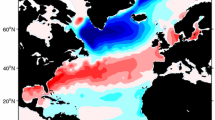Abstract
Zonal overturning circulation (ZOC) and its associated zonal heat flux (ZHF) are important components of the oceanic circulation and climate system, although these conceptions have not received adequate attentions. Heaving induced by inter-annual and decadal wind stress perturbations can give rise to anomalous ZOC and ZHF. Based on a simple reduced gravity model, the anomalous ZOC and ZHF induced by idealized heaving modes in the world oceans are studied. For example, in a Pacific-like model basin intensified equatorial easterly on decadal time scales can lead to a negative ZOC with a non-negligible magnitude (–0.3×106 m3/s) and a considerable westward ZHF with an amplitude of–11.2 TW. Thus, anomalous ZOC and ZHF may consist of a major part of climate signals on decadal time scales and thus play an important role in the oceanic circulation and climate change.
Similar content being viewed by others
References
Behringer D W, Ji M, Leetmaa A. 1998. An improved coupled model for ENSO prediction and implications for ocean initialization. Part I: The ocean data assimilation system. Mon Wea Rev, 126(4): 1013–1021
Bindoff N L, McDougall T J. 1994. Diagnosing climate change and ocean ventilation using hydrographic data. J Phys Oceanogr, 24(6): 1137–1152
Carton J A, Giese B S. 2008. A reanalysis of ocean climate using Simple Ocean Data Assimilation (SODA). Mon Wea Rev, 136(8): 2999–3017
England M H, McGregor S, Spence P, et al. 2014. Recent intensification of wind-driven circulation in the Pacific and the ongoing warming hiatus. Nature Climate Change, 4(3): 222–227
Ganachaud A, Wunsch C. 2000. Improved estimates of global ocean circulation, heat transport and mixing from hydrographic data. Nature, 408(6811): 453–457
Huang R X. 1987. A three-layer model for wind-driven circulation in a subtropical-subpolar basin. Part I: Model formulation and the Subcritical state. J Phys Oceanogr, 17(5): 664–678
Huang R X. 2010. Ocean Circulation: Wind-driven and Thermohaline Processes. Cambridge: Cambridge University Press, 791
Huang R X. 2015. Heaving modes in the world oceans. Climate Dynamics, doi: 10.1007/s00382-015-2557-6
Lozier M S, Leadbetter S, Williams R G, et al. 2008. The spatial pattern and mechanisms of heat-content change in the North Atlantic. Science, 319(5864): 800–803
Lozier M S, Roussenov V, Reed M S C, et al. 2010. Opposing decadal changes for the North Atlantic meridional overturning circulation. Nat Geosci, 3: 728–734
Lyman J M, Johnson G C. 2008. Estimating annual global upperocean heat content anomalies despite irregular in situ sampling. J Climate, 21(21): 5629–5641
McGregor S, Sen Gupta A, England M H. 2012. Constraining wind stress products with sea surface height observations and implications for Pacific Ocean sea level trend attribution. J Climate, 25(23): 8164–8176
Meehl G A, Arblaster J M, Fasullo J T, et al. 2011. Model-based evidence of deep-ocean heat uptake during surface-temperature hiatus periods. Nature Climate Change, 1: 360–364
Meehl G A, Hu A X, Arblaster J M, et al. 2013. Externally forced and internally generated decadal climate variability associated with the Interdecadal Pacific Oscillation. J Climate, 26(18): 7298–7310
Schmitz W J. 1986a. On the world ocean circulation: Volume I, Some global features/North Atlantic circulation. Woods Hole Oceanographic Institution Technical Report WHOI-96-03, 148
Schmitz W J. 1986b. On the world ocean circulation: Volume II, the Pacific and Indian Oceans/A global update. Woods Hole Oceanographic Institution Technical Report WHOI-96-08, 241
Talley L D. 2013. Closure of the global overturning circulation through the Indian, Pacific, and Southern Oceans: Schematics and transports. Oceanography, 26: 80–97
Talley L D, Pickard G L, Emery W J, et al. 2011. Descriptive Physical Oceanography: An Introduction (Sixth Edition). Boston: Elsevier, 560
Author information
Authors and Affiliations
Corresponding author
Additional information
Foundation item: The CAS/SAFEA International Partnership Program for Creative Research Teams of Chinese Academy of Sciences; the National Natural Science Foundation of China under contract Nos 41422601, 41376024 and 41376025.
Rights and permissions
About this article
Cite this article
Tan, W., Huang, R.X., Wang, W. et al. Zonal overturning circulation and heat flux induced by heaving modes in the world oceans. Acta Oceanol. Sin. 34, 80–91 (2015). https://doi.org/10.1007/s13131-015-0751-3
Received:
Accepted:
Published:
Issue Date:
DOI: https://doi.org/10.1007/s13131-015-0751-3




